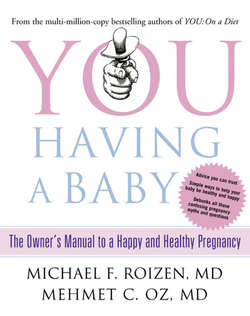Читать книгу You: Having a Baby: The Owner’s Manual to a Happy and Healthy Pregnancy - Michael Roizen F. - Страница 61
The Plump Position: When Big Is Bad
ОглавлениеIn some circles, there seems to be a sort of badge of honor that comes with carrying and delivering a big baby. We celebrate with—and even admire—moms who can carry and deliver kids who enter this world the size of dishwashers. But there are many reasons why you don’t want your baby to be too big at birth. As we said, you’re programming your child to store weight later in life. Plus, you’re opening yourself up to more potential complications at birth as well as the risk of future conditions such as adult-onset diabetes.
One of the reasons we see XXL babies is because of a metabolic problem in mom called gestational diabetes. Many of us assume that the only way to get diabetes is by pummeling your insides with a four-a-day cheesecake habit, but gestational diabetes works a bit differently. (See “What’s Food Got to Do with It?” on page 96.)
To see exactly how it works, let’s take a closer look at glucose metabolism. When hPL causes the changes that increase maternal blood glucose, this leaves more glucose circulating in mom’s bloodstream, available to satisfy the glucose-greedy fetus. That’s a good thing. Bubba needs glucose to grow. But it comes with a price.
To counteract those rising sugar levels as your pregnancy progresses, you secrete more insulin. So the placenta responds by pumping out even more hPL, which limits the effectiveness of that extra insulin. If your muscles and liver cannot easily use up all that sugar, you may end up with too much glucose floating around in your blood. That’s called insulin resistance, and in some moms, the vicious hPL-insulin cycle escalates into full-blown gestational diabetes (a risk factor, by the way, for prenatal and postpartum depression).
One problem with gestational diabetes is that mom’s excess sugar freely passes through the placenta to the fetus. In response to this excess sugar in its blood, the
